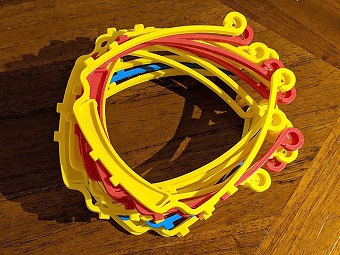University IT Director Uses 3D Printer to Make Protective Face Shields
(LEBANON, Ill., April 14, 2020) — When McKendree University’s director of information
technology read about health care workers’ urgent plea for personal protective equipment
during the novel coronavirus (COVID-19) pandemic, he found a way to address the need.
“I saw how China, then Europe, began running out of face masks during this pandemic
and the U.S. has been trending a week or two after Europe, so I knew we would have
similar issues soon,” said George Kriss. “I ran across an article about people in
other European countries helping hospitals offset these shortages by 3D-printing visors. I
immediately thought this would be a great use of our 3D printer, which was currently
sitting idle.”
The 3D printer sat idle after McKendree moved its spring semester classes online in
March. Faculty and staff members are currently working remotely, in accordance with
the “stay-at-home” order issued by the Illinois governor through at least April 30.
Kriss retrieved the printer from “theHub,” the Lebanon campus’s collaborative technology
center, and brought it home. During the workday, he is ensuring all McKendree systems
and services remain operational with his team by monitoring servers, network operations,
providing remote technical support and supporting faculty and students for their continued
success. After hours and on weekends, he is printing protective visors, a few at a
time, for front line health care workers at local hospitals.
The visor frame is a halo-style headband, from which a standard size overhead projector
transparency sheet can be fastened to create a protective face shield. When used in
conjunction with a face mask, the transparent face shield limits exposure to airborne
droplets and splatters from the front and above. It also acts as a barrier to prevent
the wearer from directly touching his or her face, which minimizes the risk of transmitting
the coronavirus. "The face shield can be reused by one or multiple wearers; simply disinfecting the
visor and headband is all that is needed," Kriss said.
He is using a Swedish design approved and made available by the National Institutes
of Health (NIH). “The most accepted design is from Erik Cederberg,” he explained. “His design was initially for the Swedish health system, but it got picked up and
approved for the European Union and the NIH system. These approvals helped it get
widely accepted for the U.S. hospital systems.”
The process takes about an hour to print and assemble two face shields. It took Kriss
some time, he said, to make all the tweaks necessary for mass production on his basement assembly line. He has two helpers—his daughters, Lillian, age 5, and Adelyn, 3. He expects more updates and challenges will occur as he refines his 3-D printing skills
or needs to devote time and attention elsewhere.
The eventual goal is to make 500 face shields for hospitals and health care workers. “My wife and I have given some to people who have seen the visors and asked about them, as well as some neighbors who have various frontline
roles,” Kriss said.

-McK-
